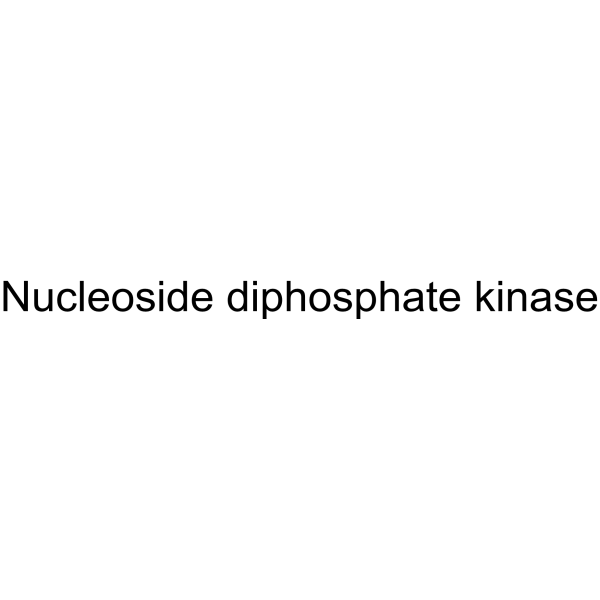Nucleoside diphosphate kinase

Nucleoside diphosphate kinase structure
|
Common Name | Nucleoside diphosphate kinase | ||
|---|---|---|---|---|
| CAS Number | 9026-51-1 | Molecular Weight | N/A | |
| Density | N/A | Boiling Point | N/A | |
| Molecular Formula | N/A | Melting Point | N/A | |
| MSDS | USA | Flash Point | N/A | |
|
Initial characterization of the human central proteome.
BMC Syst. Biol. 5 , 17, (2011) On the basis of large proteomics datasets measured from seven human cell lines we consider their intersection as an approximation of the human central proteome, which is the set of proteins ubiquitously expressed in all human cells. Composition and properties... |
|
|
Complete sequencing and characterization of 21,243 full-length human cDNAs.
Nat. Genet. 36 , 40-5, (2004) As a base for human transcriptome and functional genomics, we created the "full-length long Japan" (FLJ) collection of sequenced human cDNAs. We determined the entire sequence of 21,243 selected clones and found that 14,490 cDNAs (10,897 clusters) were unique... |
|
|
The finished DNA sequence of human chromosome 12.
Nature 440(7082) , 346-51, (2006) Human chromosome 12 contains more than 1,400 coding genes and 487 loci that have been directly implicated in human disease. The q arm of chromosome 12 contains one of the largest blocks of linkage disequilibrium found in the human genome. Here we present the ... |
|
|
The status, quality, and expansion of the NIH full-length cDNA project: the Mammalian Gene Collection (MGC).
Genome Res. 14 , 2121-7, (2004) The National Institutes of Health's Mammalian Gene Collection (MGC) project was designed to generate and sequence a publicly accessible cDNA resource containing a complete open reading frame (ORF) for every human and mouse gene. The project initially used a r... |
|
|
Lysine acetylation targets protein complexes and co-regulates major cellular functions.
Science 325(5942) , 834-40, (2009) Lysine acetylation is a reversible posttranslational modification of proteins and plays a key role in regulating gene expression. Technological limitations have so far prevented a global analysis of lysine acetylation's cellular roles. We used high-resolution... |
|
|
Lys-N and trypsin cover complementary parts of the phosphoproteome in a refined SCX-based approach.
Anal. Chem. 81(11) , 4493-501, (2009) The analysis of proteome-wide phosphorylation events is still a major analytical challenge because of the enormous complexity of protein phosphorylation networks. In this work, we evaluate the complementarity of Lys-N, Lys-C, and trypsin with regard to their ... |
|
|
Elimination and utilization of oxidized guanine nucleotides in the synthesis of RNA and its precursors.
J. Biol. Chem. 288(12) , 8128-35, (2013) Reactive oxygen species are produced as side products of oxygen utilization and can lead to the oxidation of nucleic acids and their precursor nucleotides. Among the various oxidized bases, 8-oxo-7,8-dihydroguanine seems to be the most critical during the tra... |
|
|
The DNA sequence and biological annotation of human chromosome 1.
Nature 441 , 315-321, (2006) The reference sequence for each human chromosome provides the framework for understanding genome function, variation and evolution. Here we report the finished sequence and biological annotation of human chromosome 1. Chromosome 1 is gene-dense, with 3,141 ge... |
|
|
The sequence and analysis of duplication-rich human chromosome 16.
Nature 432(7020) , 988-94, (2004) Human chromosome 16 features one of the highest levels of segmentally duplicated sequence among the human autosomes. We report here the 78,884,754 base pairs of finished chromosome 16 sequence, representing over 99.9% of its euchromatin. Manual annotation rev... |
|
|
DNA sequence of human chromosome 17 and analysis of rearrangement in the human lineage.
Nature 440(7087) , 1045-9, (2006) Chromosome 17 is unusual among the human chromosomes in many respects. It is the largest human autosome with orthology to only a single mouse chromosome, mapping entirely to the distal half of mouse chromosome 11. Chromosome 17 is rich in protein-coding genes... |